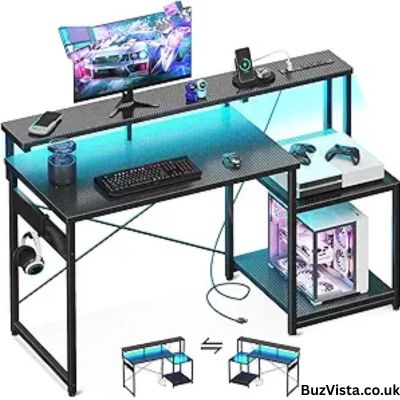Every serious gamer knows that your chair, your display, and your peripherals all matter — but your desk is the foundation. A great gaming desk gives you the room, ergonomics, cable management, and stability to build a setup you love. In this guide, we walk through everything you need to know about gaming desks: design principles, features to prioritize, pitfalls to avoid, and how to pick the ideal model. Whether you’re planning a dual-monitor rig, streaming setup, or compact battlestation, you’ll find value here.
Why a Gaming Desk Deserves Special Thought
A “gaming desk” is often marketed with flashy RGB accents, cup holders, headphone hooks, and sleek shapes. But beyond the style, what separates a truly useful gaming desk from a standard office desk are:
- Ergonomic support at high performance
Gamers often sit many hours at a stretch. A desk that supports good posture, and potentially alternates between sitting and standing, helps reduce fatigue and improve concentration. - Space for premium gear
High-end keyboards, large mouse pads, multiple monitors, controllers, capture cards, external audio gear—all need room and thoughtful layout. - Smart cable management
Gaming setups often involve many cables—power, monitor, USB, network. A desk designed with cable trays, channels, grommets, and routing paths helps the rig stay clean, safer, and better organized. - Stability under load
A solid frame resists wobble when typing or leaning, even when your rig is loaded with peripherals, a PC tower, and monitors. - Aesthetic & personal branding
Many gaming desks incorporate visual elements that align with gaming culture—RGB lighting, textured tops, futuristic shapes—which appeal to the marketplace and help your desk feel like part of your overall gaming “identity.”
A good gaming desk blends style with practicality. Once you know what to look for, you’ll see how models differ.
Dimensions & Layout: How Big Should Your Gaming Desk Be?
Single vs Dual Monitor (and beyond)
- Single-monitor setups: Many guides advocate a desk width of around 120 cm (≈ 47 inches). That gives enough space for a monitor, keyboard, mouse, and a few accessories in front. Depth of 60–70 cm is typically enough to maintain a comfortable viewing distance.
- Dual monitors / ultrawide + peripherals: Once you go dual, or add extra gear (streaming camera, mixer, external audio interfaces), you’ll want 160 cm or more in width and 70–80 cm depth. This extra real estate ensures you’re not cramped or pushing gear off the edge.
- Streamer/Creator rigs / L-shaped setups: If you have a PC tower, multiple displays, lighting arms, maybe an audio workstation or even a console, an L-shaped or corner desk (150+ cm per side) can let you separate zones (one for gaming, one for “studio”).
Tip: Leave some empty “breathing room” on the desk — 10–20 cm unused space along edges or behind your peripheral zones. This margin gives room for future expansion or repositioning.
Thickness, Overhang, & Clearance
- Desk tops are often 18–25 mm thick (MDF, particleboard, or wood laminate). Heavier thickness improves rigidity but adds weight.
- Overhang (how far the top extends over the frame) is typically 20–30 mm. A slight overhang gives you a smoother edge while still protecting the frame.
- Crucially, leg/foot clearance makes a difference. Designers aim for ~65–75 cm of vertical space under the table for legs—if you go with a sit-stand frame, subtract the height of the motor/mechanism.
Key Features to Prioritize
Here’s a checklist of features to highlight in your article (use for comparison tables or buying tips):
| Feature | Why It Matters | Ideal Specification / Notes |
|---|---|---|
| Frame & stability | Prevents wobble & flex when gaming or leaning | Welded steel, cross-bracing or X-bars, load rating of ≥ 70 kg |
| Height adjustability | Helps with posture, allows sit/stand transitions | At least ~70 cm to ~115-120 cm stroke (depending on user height) |
| Cable management | Reduces clutter, protects wires, easier maintenance | Under-desk trays, cable channels, grommets, Velcro/straps |
| Monitor arm compatibility / cutout | Enables clean multi-monitor setups, saves desk real estate | Clear back edges or cutouts, support for VESA arms |
| Surface material & finish | Affects durability, feel, and aesthetics | Laminated MDF, scratch-resistant coating, textured or matte finish |
| Peripheral support | Accommodates your mousepad, controller zones, headphone/console ports | Full-width mouse mat (≥ 40 cm depth), headset hook, cup holder, power strip hold |
| Expansion & modularity | Flexibility for future gear | Accessory mounts, modular add-ons (shelves, drawers, LED bars) |
| Weight capacity | Ensures your build (PC + monitors + peripherals) is safe | Look for ≥ 70-100 kg capacity for heavier rigs |
In your article, you can break down which features are optional vs essential, especially for buyers on a budget vs premium buyers.
Sit-Stand Gaming Desks: Are They Worth It?
Gaming and standing desks might seem like a contradictory pairing—but they’re becoming popular in the competitive space.
Pros
- Reduced fatigue & better posture — switching posture helps your body reset. For long gaming or editing sessions, it combats slouching.
- Improved circulation — standing periodically is healthier than being sedentary for hours.
- Creative variation — for streamers/editors who alternate between gaming and light work, the flexibility is appealing.
Cons / Pitfalls
- Motor noise or shake — cheap motors or weak frames may wobble when typing hard or during intense gameplay.
- Transition time — it takes a moment to move desk height; abrupt changes mid-game can be jarring.
- Clearance & reach — your monitor arm, keyboard tray, and cables must all adjust without interference.
Setup Tips
- For someone ~170–180 cm tall, a standing height range of ~100 to ~120 cm is often ideal.
- Use monitor arms and cable flex tracks so that your cables always stay within safe bend radii during transitions.
- Keep your keyboard and mouse stable—don’t rely on lightweight trays that shift when height is adjusted.
In your article, you can include a mini Q&A: “Is a standing gaming desk really necessary?” and weigh pros/cons for casual vs hardcore users.
Comparing Types of Gaming Desks
Fixed (Non-adjustable) Gaming Desks
Pros:
- Lower cost
- Simpler construction, fewer parts (less to break)
- Often greater rigidity per price point
Cons:
- No height versatility
- Not ideal for posture swap or alternation
Sit-Stand / Electric Adjustable Desks
Pros:
- Height flexibility
- Better long-term ergonomics
Cons:
- Higher cost
- Added mechanical complexity & maintenance
L-Shaped / Corner Desks
Pros:
- Space to partition multiple zones
- Great for mixed use (gaming + workstation)
Cons:
- Might require more floor space
- More cable running complexity
Compact / Desk with Storage
Some desks trade width or adjustability in favor of integrated storage: drawers, shelves, side cubbies. These are great if space is tight—but often reduce leg clearance or make cable routing trickier.
Click here to discover high-quality gaming desks that blend comfort, style, and performance!
Buying Strategy & Budget Tier
To help readers pick a desk, you can break down by budget tier:
- Budget / Entry (≈ mid-low price range)
Look for simple fixed desks with good frame thickness, cable grommets, and a mouse mat. You may sacrifice adjustability or premium materials. - Midrange / Feature Balanced
Here you can expect manageably strong frames, more accessories (headset hook, cup holder), better finishes, and sometimes manual height adjustment or limited electric adjustability. - Premium / Gaming & Ergonomic Hybrids
High-end sit-stand models, heavy loads supported, modular design, strong warranty, clean aesthetics. Ideal for serious gamers or creator setups.
When writing, you can spotlight one or two pick ideas per tier (you don’t need to name brands, but you can mention the kinds of specs to expect).
Setup & Configuration Best Practices
Once someone owns a gaming desk, what should they do to get the best experience? Include a “Setup Checklist” in your article:
- Begin with cable routing: Plan front-to-back under the desk; use Velcro, cable channels, and trays.
- Mount your monitors on VESA arms to reduce desk footprint and get flexible angles.
- Use a full desk-size mousepad to cover cross-desks zones and unify movement.
- Headset hook & power strip position: Place hooks underneath, power strips in rear tray to keep the top clean.
- Leave expansion room: Don’t jam every inch with gear; keep 10–20 cm open zones for future add-ons.
- Test stability: Push from keyboard area, lean, tap—if it wobbles, tighten bolts or re-evaluate frame.
- Calibration of height (for sit-stand): Start at seated height; move to standing and check your elbow/monitor alignment at both extremes.
- Periodic check & maintenance: Retighten screws seasonally, clean grommets and cable trays, inspect motor tracks if adjustable model.
Common Mistakes & Myths to Dispel
- Myth: Bigger = always better.
If your room doesn’t allow it, a compact but well thought-through desk is better than a huge, impractical one. - Mistake: Ignoring cable slack on adjustable desks.
If you don’t have cable loops or flex tracks, you risk dragging or chafing wires when you change height. - Myth: RGB and flashy features are essential.
Style is secondary. Stability, ergonomics, and layout matter more. Cut corners on lighting, not structure. - Mistake: Buying based solely on marketed “gaming” label.
Many non-gaming desks have better build quality and fewer gimmicks. Encourage readers to compare specs, not names. - Myth: All sit-stand desks wobble.
Not true—quality dual-motor desks, especially with thicker frames and cross-bracing, have minimal vibration.
Sample Use Cases & Recommendations (Hypothetical Persona Scenarios)
You can frame in your article a few “persona” setups:
- Streamer / Content Creator Max
Needs 3 monitors, mic arm, green screen arm, camera, capture card, lighting. Go for L-shaped, sit-stand, thick frame, robust cable routing. - Casual Dual Monitor Gamer
Wants smooth mouse movement, maybe console dock, headset mount, mounted monitors. A 160 cm fixed desk with strong frame and cable tray works great. - Minimalist / Budget Entry
Just one monitor, small PC tower, basic headset. 120 cm fixed desk with good cable holes and clean top finish gives a solid - stepping stone to upgrades later.
Trends & What’s Next in Gaming Desks
- Modular add-ons: Shelves, side racks, vertical towers for water cooling or consoles.
- Smart desks: IoT integration, charging ports, LED control, wireless charging pads.
- Eco & sustainable materials: Reclaimed wood, bamboo, composite boards with better environmental profiles.
- Ultra-low vibration frames: Especially for pro gamers who value rock-solid keypress/strafing stability.
You can include a short “What to watch for in 2026/2027” sidebar in your article.
✨ Click here to discover high-quality gaming desks that blend comfort, style, and performance!
Final Thoughts
Choosing the right gaming desk is less about flashy extras and more about meeting your needs consistently over years. Prioritize stability, layout, cable management, comfort, and a design that lets you expand. If you build around core principles—and not just the flashiest RGB—you’ll end up with a rig that works, looks clean, and holds up over time. Your readers will appreciate that depth of insight.
Here’s to your next-level battlestation. — Buz Vista.

